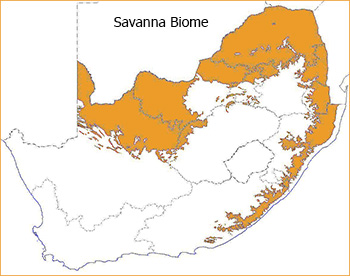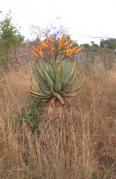The following is an extract of text from Low & Rebelo (1996) for Savanna Biome.
The Savanna Biome is the largest Biome in southern Africa, occupying 46% of its area, and over one-third the area of South Africa. It is well developed over the lowveld and Kalahari region of South Africa and is also the dominant vegetation in Botswana, Namibia and Zimbabwe. It is characterized by a grassy ground layer and a distinct upper layer of woody plants. Where this upper layer is near the ground the vegetation may be referred to as Shrubveld, where it is dense as Woodland, and the intermediate stages are locally known as Bushveld.
The environmental factors delimiting the biome are complex: altitude ranges from sea level to 2 000 m; rainfall varies from 235 to 1 000 mm per year; frost may occur from 0 to 120 days per year; and almost every major geological and soil type occurs within the biome. A major factor delimiting the biome is the lack of sufficient rainfall which prevents the upper layer from dominating, coupled with fires and grazing, which keep the grass layer dominant. Summer rainfall is essential for the grass dominance, which, with its fine material, fuels near-annual fires. In fact, almost all species are adapted to survive fires, usually with less than 10% of plants, both in the grass and tree layer, killed by fire. Even with severe burning, most species can resprout from the stem bases.
The grass layer is dominated by C 4-type grasses, which are at an advantage where the growing season is hot, but where rainfall has a stronger winter component, C 3-type grasses dominate. The shrub-tree layer may vary from 1 to 20 m in height, but in Bushveld typically varies from 3 to 7 m. The shrub-tree element may come to dominate the vegetation in areas which are being overgrazed.
Most of the savanna vegetation types are used for grazing, mainly by cattle or game. In the southernmost savanna types, goats are the major stock. In some types crops and subtropical fruit are cultivated. These mainly include the Clay Thorn Bushveld (14), parts of Mixed Bushveld (18), and Sweet Lowveld Bushveld (21). Urbanization is not a problem, perhaps because the hot, moist climate and diseases (sleeping sickness, malaria) hindered urban development.
Conservation of savanna is good in principle, mainly due to the presence of the Kruger and Kalahari Gemsbok National Parks within the biome. Similarly, in neighbouring countries, large reserves occur, such as Etosha, Gemsbok, Chobe and Hwange National Parks and the Central Kalahari Game Reserve. However, this high area conserved in South Africa, belies the fact that half of savanna vegetation types are inadequately conserved, in having less than 5% of their area in reserves. However, much of the area is used for game-farming and can thus be considered effectively preserved, provided that sustainable stocking levels are maintained. The importance of tourism and big game hunting in the conservation of the area must not be underestimated.
Click images to enlarge









